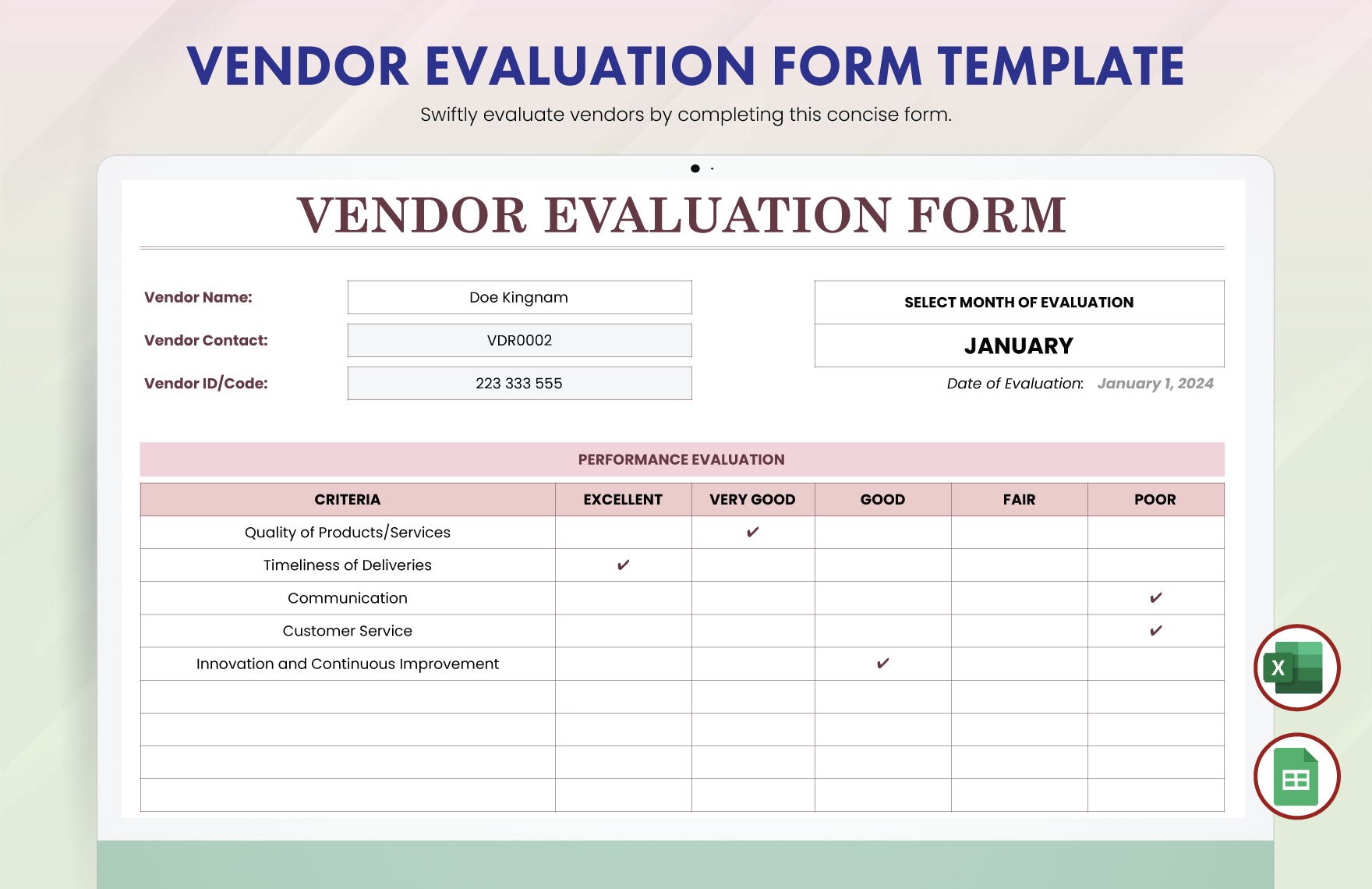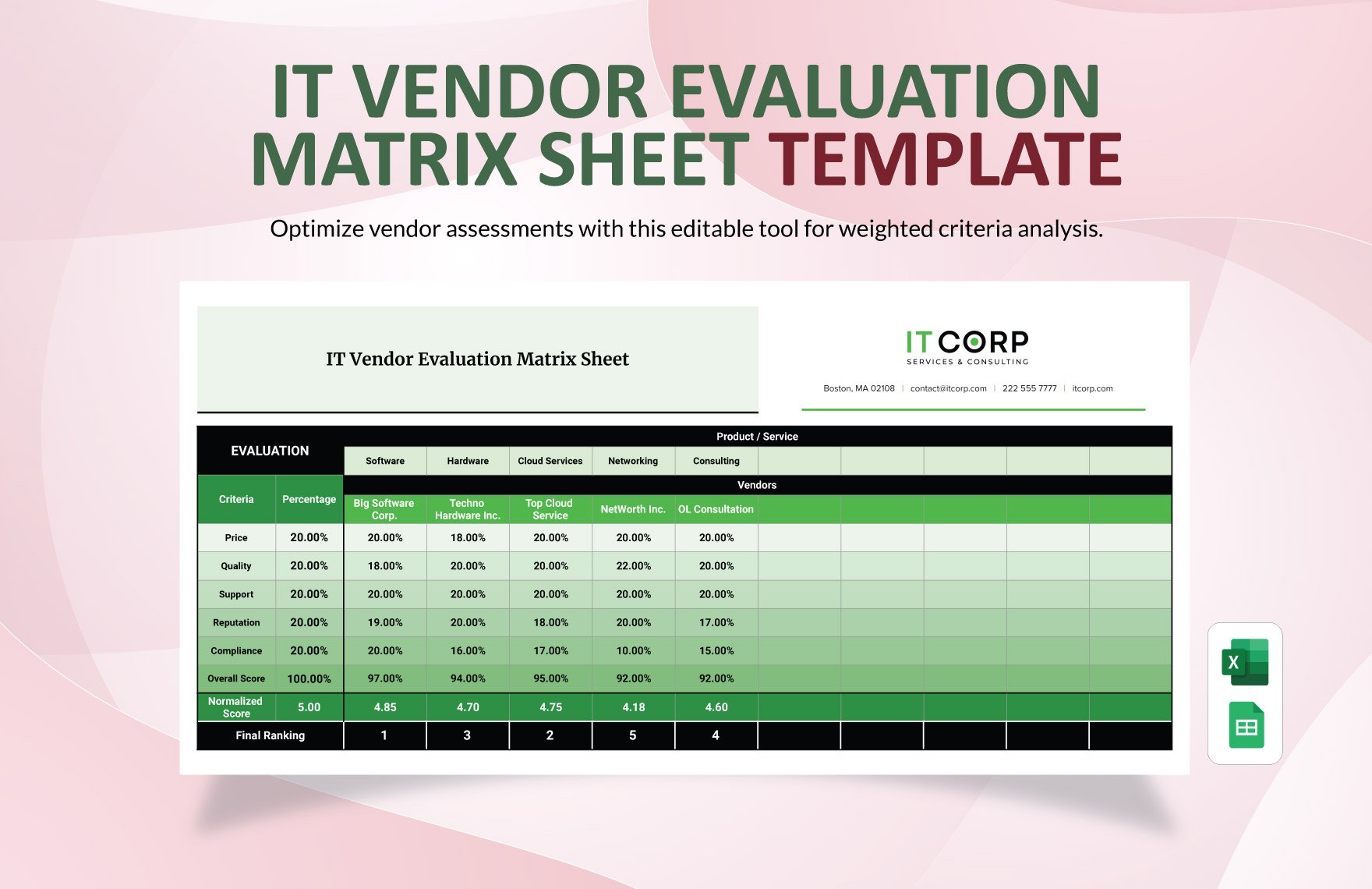The Vendor Evaluation Template in Excel That Works: Streamlining Your Procurement Process
Choosing the right vendor is crucial for the success of any business. Whether you’re sourcing raw materials, software, or professional services, a poor vendor selection can lead to project delays, increased costs, and damaged reputation. That’s where a robust vendor evaluation process comes in. And what better tool to help you manage this process than a well-designed vendor evaluation template in Excel? This article will guide you through creating and utilizing a powerful Excel template that streamlines your vendor selection, ensuring you choose the best partner for your needs.
Why Use a Vendor Evaluation Template in Excel?
Excel offers a versatile and accessible platform for vendor evaluation. Compared to more complex software solutions, a template in Excel provides several key advantages:
- Cost-Effective: You likely already have Excel, eliminating the need for additional software expenses.
- Customizable: Tailor the template to your specific industry, requirements, and evaluation criteria.
- User-Friendly: Most users are familiar with Excel, making it easy to input data, analyze results, and collaborate.
- Flexible: Adapt the template as your needs evolve and your vendor evaluation process matures.
- Easy to Share: Share the template with team members for collaborative input and analysis.
Building Your Powerful Excel Vendor Evaluation Template: Key Components
Here’s a breakdown of the essential elements to include in your Excel vendor evaluation template:
1. Vendor Information Section:
- Vendor Name: Clearly identify each vendor being evaluated.
- Contact Information: Include key contact details (name, title, email, phone number) for each vendor.
- Date of Evaluation: Track the date the evaluation was performed for record-keeping.
- Evaluation Team: List the individuals involved in the evaluation process.
2. Evaluation Criteria and Rating Scale:
This is the heart of your template. Define the criteria you’ll use to assess each vendor. Examples include:
- Quality of Products/Services:
- Adherence to specifications
- Reliability and durability
- Warranty and support
- Price and Cost:
- Pricing structure and competitiveness
- Payment terms
- Hidden costs
- Delivery and Timeliness:
- Lead times
- Delivery reliability
- Shipping costs
- Financial Stability: (For larger contracts)
- Years in business
- Financial health (e.g., credit rating, financial statements)
- Technical Capability:
- Expertise and experience
- Technology infrastructure
- Innovation and research and development
- Customer Service and Support:
- Responsiveness to inquiries
- Problem-solving capabilities
- Availability of support resources
- Compliance and Risk:
- Regulatory compliance
- Insurance coverage
- Data security practices
Rating Scale: Establish a consistent rating scale (e.g., 1-5, Poor to Excellent) for each criterion.
3. Data Input and Calculation:
- Input Fields: Create columns for each evaluation criterion.
- Rating Input: Allow evaluators to input their ratings for each criterion.
- Weighting (Optional): Assign weights to each criterion based on its importance (e.g., Price might be weighted 20%, Quality 30%, etc.). This allows you to prioritize certain aspects of the evaluation.
- Calculations: Use Excel formulas to calculate:
- Weighted Scores: (Rating * Weight) for each criterion.
- Total Weighted Score: Sum of all weighted scores for each vendor.
- Average Score: (Optional) Calculate the average score across all evaluators for each criterion.
4. Results and Analysis:
- Summary Table: Create a table that displays the total weighted score for each vendor, allowing for easy comparison.
- Ranking: Rank vendors based on their total scores.
- Conditional Formatting: Use conditional formatting to highlight top-performing vendors (e.g., green for scores above a certain threshold, red for scores below).
- Charts and Graphs (Optional): Visualize the results using charts (e.g., bar charts comparing total scores, pie charts showing the breakdown of weighted scores).
5. Supporting Documentation:
- Comments Section: Provide a space for evaluators to add qualitative comments and justifications for their ratings.
- Attachments (Optional): Include space to link to supporting documents (e.g., vendor proposals, references, contracts).
Tips for Effective Template Design
- Keep it Simple: Avoid unnecessary complexity. A clear and concise template is easier to use and understand.
- Use Clear Labels: Use descriptive headers and labels for all criteria and columns.
- Consistency: Maintain consistent formatting and rating scales throughout the template.
- Protect the Formula Fields: Protect cells containing formulas to prevent accidental deletion or modification.
- Regular Review and Update: Review and update your template periodically to ensure it remains relevant and effective.
Using Your Excel Vendor Evaluation Template in Practice
- Define Your Needs: Before starting, clearly define your specific requirements and the criteria that matter most for this particular vendor selection.
- Gather Information: Collect proposals, references, and other relevant information from each vendor.
- Assign Evaluators: Assign team members to evaluate each vendor based on their expertise.
- Enter Ratings: Have each evaluator independently enter their ratings into the template.
- Analyze Results: Review the calculated scores and identify the top-performing vendors.
- Compare and Discuss: Discuss the results with the evaluation team and consider any qualitative comments provided.
- Make a Decision: Based on the evaluation results and your overall business goals, make a final vendor selection.
- Document the Process: Maintain records of the evaluation process, including the template, scores, and any supporting documentation.
Conclusion: Empowering Your Procurement with Excel
A well-designed vendor evaluation template in Excel is an invaluable tool for any business seeking to improve its procurement process. By following the guidelines outlined in this article, you can create a powerful template that helps you objectively assess vendors, make informed decisions, and ultimately select the best partners for your success. The flexibility and accessibility of Excel make it a perfect solution for businesses of all sizes, ensuring a streamlined and efficient vendor selection process.
FAQs about Vendor Evaluation Templates in Excel
1. Can I download a pre-made vendor evaluation template in Excel?
Yes, many free and paid vendor evaluation templates are available online. Search for “vendor evaluation template Excel download” to find various options. However, consider customizing a template to fit your specific needs.
2. How do I weight the criteria in my Excel template?
To weight criteria, add a column for “Weight” next to each criterion. Assign a percentage weight (e.g., 0.20 for 20%) to each criterion, ensuring the total weights add up to 1 (or 100%). Then, in your calculation, multiply the rating by the weight for each criterion.
3. How often should I update my vendor evaluation template?
Review and update your template regularly, ideally at least annually. Adjust the criteria, weighting, and scoring system based on your evolving needs, industry trends, and feedback from your team.
4. Is an Excel template sufficient for all vendor evaluations?
While an Excel template is excellent for many scenarios, for complex or high-value vendor selections, you might consider dedicated vendor management software. This software often offers advanced features like automated workflows, collaboration tools, and in-depth reporting.
5. How can I ensure objectivity in my vendor evaluation?
To ensure objectivity, clearly define your criteria, use a consistent rating scale, and involve multiple evaluators. Encourage evaluators to provide detailed comments to support their ratings. Blind the evaluators to other’s ratings and use weighted scores to minimize personal biases.




